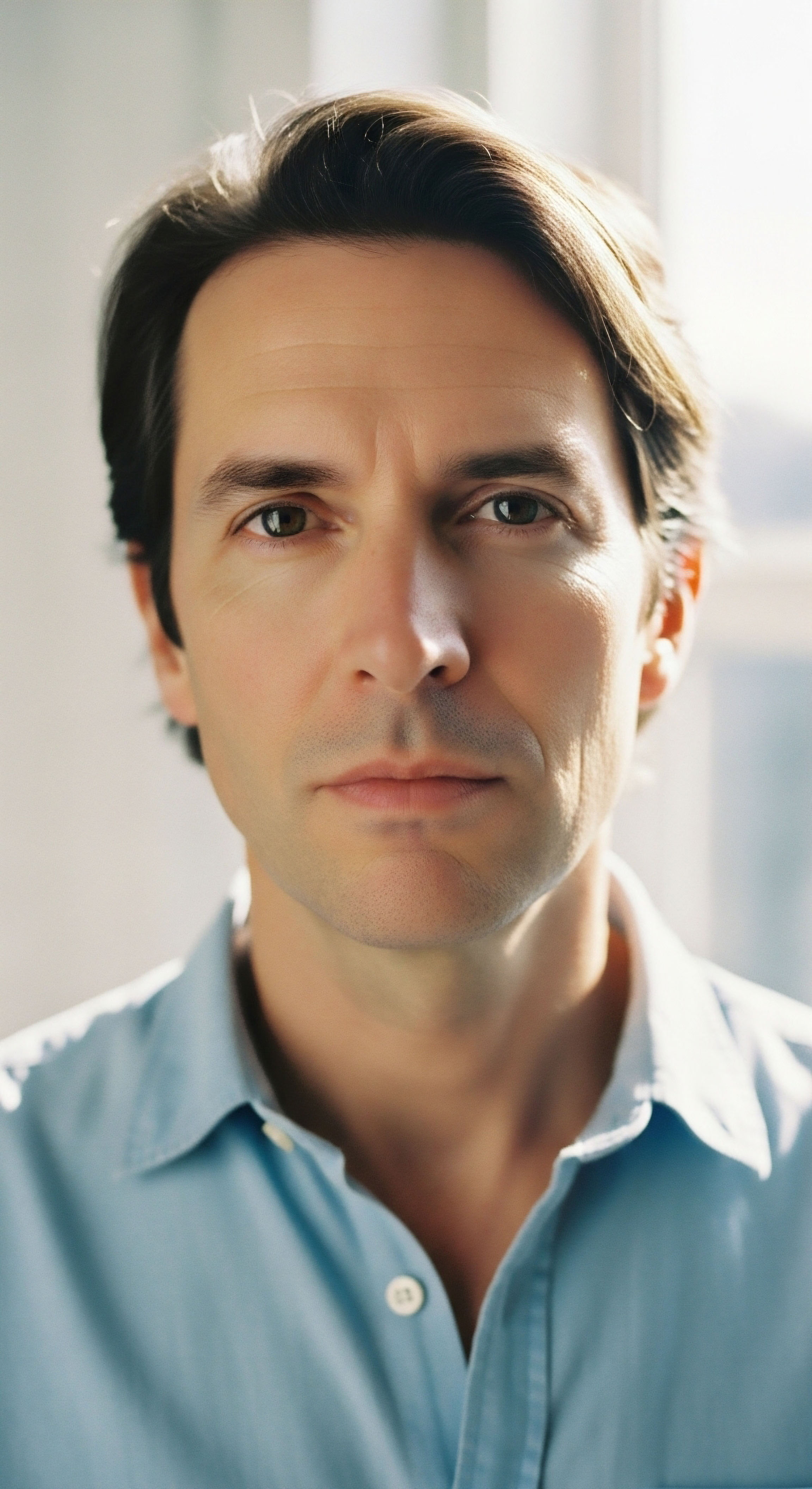

Fundamentals
Embarking on a path to optimize your hormonal health is a deeply personal and significant step. You may be seeking to restore the vitality, mental clarity, and physical strength that you feel has diminished over time. This pursuit is about reclaiming your biological capacity to function at your peak.
When considering a protocol like Testosterone Replacement Therapy (TRT), your focus is likely on resolving symptoms of low testosterone, such as fatigue, low libido, and reduced muscle mass. It is within this context of personal wellness that we must also address the foundational question of how these protocols interact with your body’s intricate reproductive systems.
The conversation about TRT is a conversation about the endocrine system, a network of glands and hormones acting as the body’s internal communication service, and its profound influence on every aspect of your well-being, including fertility.
To understand the reproductive outcomes of TRT, we must first look at the body’s own system for regulating testosterone. This is the Hypothalamic-Pituitary-Gonadal (HPG) axis. Think of it as a highly sophisticated thermostat system for your hormones.
The hypothalamus in your brain detects the body’s need for testosterone and sends a signal, Gonadotropin-Releasing Hormone (GnRH), to the pituitary gland. The pituitary, in turn, releases two key messenger hormones ∞ Luteinizing Hormone (LH) and Follicle-Stimulating Hormone (FSH). LH travels to the Leydig cells in the testes, instructing them to produce testosterone.
FSH travels to the Sertoli cells, also in the testes, where it is essential for stimulating sperm production, a process known as spermatogenesis. The testosterone produced in the testes then circulates throughout the body, and a portion of it signals back to the brain to moderate the release of GnRH, completing a delicate feedback loop that keeps the system in balance.
Introducing external testosterone through TRT signals to the brain’s regulatory centers that levels are sufficient, thereby shutting down its own natural production of key reproductive hormones.
When you begin a TRT protocol, you are introducing testosterone from an external, or exogenous, source. Your brain’s “thermostat” detects these high levels of circulating testosterone. In response, it believes its job is done. The hypothalamus drastically reduces or completely stops sending the GnRH signal to the pituitary gland.
Without the GnRH signal, the pituitary gland stops releasing LH and FSH. This halt in signaling has two direct and significant consequences for the testes. First, the absence of LH means the Leydig cells are no longer stimulated to produce the body’s own testosterone.
Second, and central to the question of reproductive outcomes, the absence of FSH means the Sertoli cells are no longer stimulated to produce sperm. This cessation of spermatogenesis is the most immediate and predictable long-term reproductive effect of conventional TRT.
The testicular environment, which requires extremely high concentrations of intratesticular testosterone for sperm maturation, experiences a sharp decline in both testosterone and the necessary signaling for fertility. This leads to a state of temporary infertility, with sperm counts often dropping to zero. This outcome is a direct and expected consequence of how the HPG axis functions.

The Biological Reality of Testicular Function
The testes are dynamic organs that respond directly to hormonal signals. Under the influence of LH and FSH, they are active, producing both hormones and sperm. When these signals cease due to exogenous testosterone, the testes enter a quiescent state. This leads to a reduction in testicular volume, commonly referred to as testicular atrophy.
This reduction in size is a physical manifestation of the shutdown of the HPG axis. The tissue is no longer performing its primary functions of spermatogenesis and endogenous testosterone production, so it naturally decreases in size. It is a biological adaptation to a changed hormonal environment.
Understanding this mechanism is key to appreciating why protocols aimed at preserving fertility during TRT are designed the way they are. They seek to provide an alternative stimulus to keep the testes active, even while the brain’s natural signals are suppressed.


Intermediate
For the individual who understands the basic impact of TRT on the HPG axis, the next logical step is to examine the clinical strategies available to manage these effects. The decision to start hormonal optimization is rarely made without considering all life goals, including the possibility of future family building.
A well-designed protocol acknowledges the biological consequences of suppressing the HPG axis and incorporates adjunctive therapies to mitigate them. These strategies are built upon a sophisticated understanding of hormonal signaling, aiming to either maintain testicular function during therapy or effectively restart it after cessation. The approach taken depends entirely on the individual’s personal goals, timeline, and unique physiological response.

Maintaining Testicular Function during TRT
The primary strategy for preserving fertility while on a testosterone optimization protocol involves providing a substitute signal for the suppressed LH. Since exogenous testosterone shuts down the pituitary’s release of LH, the testes no longer receive the message to produce intratesticular testosterone or to support sperm maturation. To counteract this, clinicians use agents that can mimic the action of LH.
- Gonadorelin ∞ This is a synthetic version of Gonadotropin-Releasing Hormone (GnRH). When administered in pulses, typically via subcutaneous injection two or more times per week, it stimulates the pituitary gland to release its own LH and FSH. This action keeps the HPG axis partially active, prompting the testes to continue producing some level of intratesticular testosterone and maintaining the necessary environment for spermatogenesis. It acts upstream, at the pituitary level, to keep the natural signaling pathway engaged.
- Human Chorionic Gonadotropin (hCG) ∞ Historically, hCG was the standard of care for this purpose. It is a hormone that is structurally very similar to LH and can bind directly to LH receptors on the Leydig cells in the testes. This binding directly stimulates testicular testosterone production and helps maintain testicular volume and sperm production. It effectively bypasses the suppressed pituitary and delivers the “on” signal straight to the testes.
In addition to maintaining testicular stimulation, managing estrogen levels is another critical component. Testosterone can be converted into estradiol, a form of estrogen, via the aromatase enzyme. While some estrogen is vital for male health, excessive levels can cause side effects and can also further suppress the HPG axis.
Anastrozole, an aromatase inhibitor, is often included in protocols to block this conversion, ensuring a balanced hormonal profile. By combining Testosterone Cypionate with agents like Gonadorelin and, when needed, Anastrozole, a protocol can be designed to deliver the systemic benefits of testosterone optimization while preventing the complete shutdown of the reproductive system.
Strategic clinical protocols can preserve testicular function during TRT by providing an alternative stimulus to the testes, effectively replacing the suppressed signals from the brain.

Comparing TRT Protocols
The choice of protocol has direct implications for reproductive health. The following table illustrates the key differences between a standard TRT protocol focused solely on symptom relief and a protocol designed with fertility preservation in mind.
| Component | Standard TRT Protocol | Fertility-Preserving TRT Protocol |
|---|---|---|
| Primary Medication | Testosterone Cypionate (or other ester) | Testosterone Cypionate (or other ester) |
| HPG Axis Impact | Suppression of LH and FSH | Suppression of endogenous LH/FSH, but with exogenous stimulation |
| Adjunctive Therapy | Typically Anastrozole only (for estrogen control) | Gonadorelin (or hCG) to stimulate testes; Anastrozole for estrogen control |
| Spermatogenesis | Severely impaired or completely ceases | Maintained, though potentially at a reduced level compared to baseline |
| Testicular Volume | Significant reduction (atrophy) | Largely preserved |

Post-Therapy Restoration of Reproductive Function
For men who did not use a fertility-preserving protocol or who wish to discontinue TRT to actively pursue conception, the focus shifts to restarting the HPG axis. The long-term outcome for most men is a return to their baseline reproductive function, although the timeline for this recovery can vary. The goal of a “restart” protocol is to accelerate this process by stimulating the body’s natural hormone production machinery.
These protocols typically use Selective Estrogen Receptor Modulators (SERMs), such as Clomiphene Citrate (Clomid) or Tamoxifen. These medications work at the level of the hypothalamus and pituitary gland. They selectively block estrogen receptors in the brain. Since estrogen is part of the negative feedback loop, blocking its action makes the brain perceive a low-hormone state.
In response, the hypothalamus releases GnRH, which in turn stimulates the pituitary to produce LH and FSH. This surge of endogenous LH and FSH provides a powerful signal to the testes to resume testosterone and sperm production. Enclomiphene is a more refined option, an isomer of clomiphene that is thought to have a more targeted pro-gonadotropic effect with fewer side effects.
The duration of TRT is a significant factor in the speed and success of recovery; shorter durations of use generally correlate with a quicker return to baseline function. For most men, sperm production returns within several months to a year after cessation, but a structured restart protocol can often expedite this timeline.


Academic
A sophisticated analysis of the long-term reproductive outcomes for men on TRT requires moving beyond the immediate cause-and-effect relationship of HPG axis suppression. A systems-biology perspective reveals a deeper connection ∞ a man’s baseline reproductive health, particularly his semen quality, can serve as a powerful prognostic indicator for his future endocrine function and potential need for androgen replacement.
Research indicates that men who require assisted reproductive technologies (ART) like Intracytoplasmic Sperm Injection (ICSI) to conceive are significantly more likely to be prescribed TRT later in life. This suggests a shared underlying pathophysiology that links subfertility and hypogonadism, framing male infertility as a potential early manifestation of a more systemic endocrine vulnerability.

What Is the Link between Infertility and Future Hypogonadism?
The association between male factor infertility and a future need for TRT points to a compromised Hypothalamic-Pituitary-Gonadal (HPG) axis that may be present long before a man seeks treatment for hypogonadal symptoms. ICSI is typically employed in cases of severe male infertility, such as very low sperm count (oligozoospermia) or poor sperm motility (asthenozoospermia).
These conditions often reflect suboptimal testicular function, which may stem from impaired Leydig cell capacity to produce testosterone or impaired Sertoli cell function. While the intratesticular testosterone concentration may be sufficient for some level of systemic function in a younger man, it may be inadequate for the robust demands of spermatogenesis.
This state of compensated or subclinical hypogonadism can exist for years. As the man ages, the natural age-related decline in testicular function exacerbates this underlying condition, eventually leading to clinically significant hypogonadism with systemic symptoms that prompt him to seek TRT. Therefore, the initial infertility diagnosis can be viewed as the first clinical sign of a less resilient endocrine system.
Subfertility in young men, particularly that requiring advanced reproductive technologies, may represent an early indicator of a latent systemic endocrine dysfunction that progresses to clinical hypogonadism over time.
This perspective reframes the clinical approach. Instead of viewing TRT-induced infertility as an isolated side effect, we can see the entire arc ∞ from subfertility to hypogonadism to TRT ∞ as a continuum of endocrine health. A young man presenting with infertility should be considered at higher risk for future androgen deficiency.
This warrants not just a fertility workup but a comprehensive endocrine evaluation and long-term monitoring. This proactive approach allows for early identification of declining testosterone levels and timely intervention, potentially with preventative lifestyle modifications or, eventually, a carefully managed TRT protocol that acknowledges his reproductive history from the outset.

Hormonal Signaling Pathways and Their Disruption
To fully appreciate this connection, a detailed examination of the hormonal signaling pathways is necessary. The table below outlines the key hormones, their functions, and how they are affected in states of primary testicular dysfunction versus exogenous TRT administration.
| Hormone/Factor | Primary Function in HPG Axis | Status in Subfertility/Primary Hypogonadism | Status During Exogenous TRT |
|---|---|---|---|
| GnRH | Stimulates pituitary to release LH and FSH. | Often elevated due to lack of negative feedback from testes. | Suppressed due to strong negative feedback from high systemic testosterone. |
| LH | Stimulates Leydig cells to produce testosterone. | Elevated as the pituitary tries to stimulate failing testes. | Suppressed to near-zero levels. |
| FSH | Stimulates Sertoli cells to support spermatogenesis. | Elevated as the pituitary tries to stimulate failing sperm production. | Suppressed to near-zero levels. |
| Intratesticular Testosterone | Essential for sperm maturation; levels are many times higher than in blood. | Reduced due to Leydig cell dysfunction. | Drastically reduced due to lack of LH stimulation. |
| Systemic Testosterone | Responsible for secondary sexual characteristics and overall well-being. | Low, leading to clinical symptoms of hypogonadism. | Maintained at optimal levels by the therapy itself. |
| Inhibin B | Produced by Sertoli cells; provides negative feedback to the pituitary to suppress FSH. | Low, reflecting poor Sertoli cell function and spermatogenesis. | Low, reflecting suppressed Sertoli cell function. |
This detailed comparison illuminates the core issue. In both primary hypogonadism and during TRT, the end result at the testicular level is similar ∞ a lack of the necessary stimulation and hormonal environment for spermatogenesis. The key difference lies in the state of the pituitary signals (LH/FSH).
In the former, they are high; in the latter, they are suppressed. This distinction is what allows for post-TRT recovery protocols using SERMs to work so effectively, as they target the restoration of this suppressed signaling cascade. The long-term reproductive outcome after discontinuing TRT is, in essence, a return to the man’s baseline endocrine state.
If that baseline was one of robust testicular function, recovery is typically complete. If the baseline was one of subclinical or compensated hypogonadism, he will return to that state, which may itself be one of subfertility.

References
- Elenkov, A. Al-Jebari, Y. Lundberg Giwercman, Y. & Giwercman, A. (2020). Testosterone replacement therapy in men who conceived with intracytoplasmic sperm injection ∞ nationwide register study. European Journal of Endocrinology, 182(4), 423 ∞ 428.
- American Society for Reproductive Medicine. (2021). Testosterone use and male infertility patient education fact sheet. ReproductiveFacts.org.
- ARC Fertility. (n.d.). The Impact of Testosterone Treatment on Male Fertility ∞ What You Should Know. Arcfertility.com.
- Hotchkiss, A. (2023). How Does TRT Affect Male Fertility? What You Should Know. The Proof with Simon Hill.
- Ferlin, A. Garolla, A. Ghezzi, M. et al. (2021). Sperm count and hypogonadism as markers of general male health. European Urology Focus, 7(1), 205-213.
- Bhasin, S. Brito, J.P. Cunningham, G.R. et al. (2018). Testosterone Therapy in Men With Hypogonadism ∞ An Endocrine Society Clinical Practice Guideline. The Journal of Clinical Endocrinology & Metabolism, 103(5), 1715 ∞ 1744.

Reflection

Charting Your Own Biological Course
The information presented here provides a map of the complex biological territory where hormonal optimization and reproductive health intersect. This knowledge is the first and most vital tool in your possession. It allows you to ask precise questions and to understand the answers with clarity. Your personal health is a dynamic, evolving system.
The decisions you make about it should be informed by a deep appreciation for its interconnectedness. Where are you in your life’s journey? What are your most important long-term goals for your vitality, your function, and your family? The answers to these questions will illuminate your unique path forward.
This clinical science is the foundation, and on it, you can build a personalized strategy that honors your body’s intricate design and your own personal definition of a life lived to its fullest potential.



